Circular Breathing on the Didgeridoo
NOTE:The first half of this lesson series is available completely free of charge. You can purchase the full set by hitting the Buy button below or by purchasing a full membership.
Introduction to Didgeridoo Circular Breathing
Circular breathing is undoubtedly the most sought after didgeridoo technique. It’s what every beginner didgeridoo player wants to be able to do… NOW!
Some people think it is a mystical technique that you can be blessed with, others think that it is something that naturally comes after you have been playing for a long time. Neither of these are true.
The fact is, circular breathing is a series of simple physical actions that anyone can learn.
In these lessons, we break the circular breathing down into small steps. Be sure to practice each step until it’s easy, then move onto the next. This is the fastest way to learn the circular breathing technique.
It might take an hour to get it… a day… or even a month. If you persist and follow our steps, you WILL be circular breathing!
Customer feedback and reviews
- “So happy to be able to watch these videos on the iPad. The videos load easily with no buffeting…Sanshi is a great teacher.” (Jeanell, USA)
- “Exciting times ahead for didj players. Very clear and delivered well.” (Chris, Australia)
- “The lessons are great! and clear and not rushed but explained fully loving it! Orse!” (Penny, Australia)
Sanshi you are an awesome guy & didge teacher, i enjoyed your videos & i will recommend you to everyone that wants to learn to play the didgeridoo.”
How to do circular breathing as explained by Benni!
There’s not a day that goes by where we’re not explaining the circular breathing technique in person to a customer at Didgeridoo Breath. Here’s a written how to put together by Benni which explains the ins and outs of circular breathing from start to finish so you can get a better understanding of how the process works…here’s Benni:
Ahh yes, circular breath….
For many aspiring didgeridoo players this seems like THE main goal in their practice. Everyday at Didgeridoo Breath and Didgeridoo Dojo we hear comments that we are hungry to dispel such as:
“I don’t have enough puff to play that”
“Nah, I’m a smoker – cant do it”
“Yea but… how do you keep it going??”
“How do you breathe in and out and the same time?”
“That’s impossible!”
etc blah blah blah……
The task is both mental and physical, and just so long as you are able to breathe in through your nose (even one nostril will do) you have total potential to accomplish this feat! Explaining the technique here in store everyday is one thing, but today I feel like laying it all down for those players out there who are curious or struggling along the path in their own private practice. Lets talk about the art of circular breathing.
HOW TO
So, as I have noted already – the task is just as much a mental challenge as it is a physical one. The first hurdle to jump mentally is the one that says “I CAN’T DO THAT”.
This may be true, but you have forgotten to add one word there…. YET. Maybe you cannot do it just yet, but if you give up before you start then what is the point to anything!
Being a practice that can be started by yourself, at any time or place, with no equipment, whilst already doing other things should make it as accessible as air itself. Why not dedicate 5 minutes each day to such a beneficial practice and kick some serious goals?
The second hurdle to jump mentally is to look at breath in a fresh and open way again. You will need to get your head around the fact that you will be multitasking here.
While you breathe in through your nose (easy!) you will be learning how to squeeze air out of your mouth using your cheeks. Your brain may feel a pinch here at this point, much like it does when someone asks if you can pat your head & rub your tummy at the same time.
Muscle memory is the key to not overthinking this move – by which I mean, just slowly & steadily repeating the action over and over will allow your body to make sense of it and give your brain a rest. I will explain in more detail about this technique soon.
The physical hurdles are basically just improving your muscle strength, and familiarity of their new uses. Areas of use here are your cheek muscles, tongue & throat muscles (those around your upper airway), and your diaphragm.
As you consciously engage with these parts of your body their strength with improve rapidly, as will your ability to control them at will. If you start to aim your breath down towards your navel instead of just the top of your chest – you will be using your diaphragm, and by using the simple training exercise explained in the next paragraph – you will be developing your cheek strength. That is the main purpose! So, lets go further ☺
Start without the didge…
So, without worrying about your didgeridoo yet, or how anything sounds (another initial distraction by so many didgeridoo players), here is an exercise for you to train yourself ready for circular breathing. The goal of this exercise is to:
–make your cheeks strong
–develop new muscle memory, and ‘get your head around’ the action of it.
Step 1
Puff up your mouth full of air (or water if you prefer).
*NOTE, you do not need any air in your lungs for this action. In fact, why not test it and show yourself how easy it is to simply hold air in your mouth separately from the lungs. Just puff them up and hold them there nice & tight. Good!
Step 2
Whilst still holding your mouthful of air, try breathing normally via your nose without changing your cheeks at this stage.
You will notice & feel that there are already two separate actions going on. Your lungs are breathing as normal, and your mouth has become a separate isolated area.
Please note that for this to work the soft muscles at back of your mouth/tongue have closed off the space within your mouth to create the seal. Your body should do this automatically anyway every time you breathe in with only your nose. When you are starting out it is helpful to feel this engagement of ‘two separate areas’ for a few breaths, as it makes you more aware of the spaces you are going to develop. So feel this for a bit and then relax again for step 3.
Step 3
Good work so far. Not too hard eh?
Now you are going to feel what it is like to make a vibration with your lips, but without using your lungs!
Ever spat out a watermelon seed or made a little fart noise with your lips/tongue? Hard to describe in writing here, but if you can make a little squeak sound with your lips that sounds like someone sliding a wet finger across a balloon, or squeaky rubber then you’ve probably got it.
It is a short wet sound and it comes from your muscles without the need to blow air. This is a nice and important point to make, because for a didgeridoo player the art of circular breathing is the art of keeping your lips vibrating at all times – including while breathing.
To achieve this we must at some point keep our lips moving without any influence from the lungs. So test yourself now in this step – can you make a little buzz sound with your lips WITHOUT using your lungs? Good! Let’s extend it then.
Step 4
Now lets take that short little squirt and extend it by bringing our cheeks into the equation more. Can you extend the vibration to 2 seconds long? Should sound like the balloon got away from you while you were blowing it up ☺
Can you extend it more? Keep trying!
Now, lets go for a squeeze that is as long and hard as you can possibly manage. Fill those cheeks back up to the brim again like you did in step 1 and see if you can squeeze out for 5 HARD SECONDS. Give it all you’ve got – and this exercise will become your muscle workout for your cheeks.
At this point be very sure that you are NOT using any air from your lungs, but only that which is trapped inside your mouth. This is a stage that many students get stuck on due to just normal conditioning of the brain and muscles.
Your brain may say to you “okay big squeeze time… lets give it everything!” and you may find yourself puffing up your lungs and adding them into the mix as well. Please be mindful of this. We do not want to blow air out of the lungs because as you will see in the next step, we will need to be breathing INTO the lungs during the squeeze.
If you are getting stuck on this one here is a tip: try doing this step with empty lungs, that way you know that you cannot possibly be blowing out also. Breathe your air out until its gone, expand your cheeks, and use your cheeks muscles to squeeze out the longest hardest horrible sound you can manage, hahaha. Yes, a few of these and you should be nice and sore. This is the muscular workout element of the training. Now, for the mind…
Step 5
Got your squeeze down? Feel like you have been laughing all day and now have sore cheeks? Good! Feel proud ☺ Almost there.
The last part of this technique is to add a breath during the squeeze.
If your squeeze is lasting for 5 seconds, the ideal time to take that breath is during second #3. Yes, just a quick little sniff in through the nose – aimed down at your navel.
If you can use your diaphragm to take that sniff you will be engaging your core and taking good fresh air down deep where the body needs it. Diaphragmic breathing feels so very good! We only want to take a short breath, and the breath MUST be shorter than the squeeze to train your muscle memory correctly.
If you were to breathe in for as long as your squeeze out – you will be left with plenty of air in your lungs, but nothing left in your cheeks to eventually continue the drone during didgeridoo play.
Practically speaking, you are playing the drone, your air is running low, your cheeks widen and take over the lip movement and you take a quick sniff of air in this opportune moment, then what ever is left still within your cheeks is relaxed and blended into the normal drone again.
We are training this muscle memory action for you now by getting the rhythm right: a short sniff in a longer squeeze. It can be challenging to work these two actions (sniffing and squeezing) out of sync initially but I’m sure you will get it.
Something to help with this tricky part is to accompany yourself with your hands to help it click in your brain. How about moving one hand outwards in a steady line as you squeeze, and have the other hand move back at you for the shorter sniff. Assigning your hands to represent the two separate actions may be of help in the beginning seeing as we probably don’t have much cheek strength yet.
Please note that on the didgeridoo you would not actually squeeze out for 5 seconds, it happens a lot faster when you are playing, but right now it is strengthening for you to do it longer and harder and to feel the best time for your breath to be in the middle. In real time the whole action takes place in a second or less!!
If you can commit to doing this exercise every day for a week or two you will definitely gain results in cheek strength & new muscle memory.
This is the time to start trying it on your didgeridoo!! See if you can drone for a while and then add your squeeze & sniff in when you are ready and relaxed. Forget how it sounds!! Your drone may sound great and your squeeze may sound horrible – BUT I guarantee that if you can keep a continual vibration going no matter what it sounds like, you are 95% there. Be patient at this point as well, and know that the best sound will come in time.
Keep the vibration going mate, and breathe a relaxed breath into your diaphragm.
Keep on working it and gain control over your cheeks. To make it continual there will be an overlap on each end of your squeeze.
For example, you are droning away on your didge and whilst still droning your cheeks will expand ready to take over the job of vibrating your lips – GO! Now the cheeks are squeezing and you have taken your sniff of air. Now you blend what is left in your cheeks by slowly relaxing them and bringing your normal drone back at the same time. Don’t worry it if sounds a bit bumpy at first, or if a little gap comes here and there – totally normal.
As your cheeks become stronger they will have the sensitivity and control to slow down your big squeeze, and more and more it will sound just like a continuation of the drone you are after, and less and less like a bad toilet joke.
BOOM. That is my explanation of circular breathing training ☺
I know there are a LOT OF WORDS here, but this article has been written in the spirit of laying down a lot of answers to circular breathing questions we get here every day. Many little riddles are tucked away here in the paragraphs – so delve deep and I hope things will make sense to you all.
Here is a quick summary of the technique:
Circular Breathing Technique Summary
–big 5 second squeeze from the cheeks (for strength training)
–little sniff of air via the nose aimed at navel, taken in the middle of that squeeze (for the timing of muscle memory)
–stop and repeat for 5 mintues (the shower is a great time for practice as you can use water in your mouth instead of air)
–marinate on that every day for a week or two (to let your body know that this is a new and important action. Use it or lose it!)
–when cheeks are strong, take it to the didgeridoo and try and keep a vibration always going without worrying how good it sounds
–steadily overlap both ends of your squeeze exercise into your drone
–relax your cheeks more and more during the squeeze to maintain the correct drone vibration and do away with the tight squeeze (ability comes with strength & practice)
–disco.
Congratulations in advance my friend! Remember, time and practice is key in accomplishing this amazing breathing technique.
Once you feel strong in the cheek department, this is the time to grab yourself a fine & beautifully handcrafted didgeridoo from us. Something with good backpressure and capable of producing the amazing sounds that will surely follow, now that you have taken a serious step along your didgeridoo path.
Know as well that being able to play an amazing instrument without stopping is only ONE cool benefit of learning this technique! Circular breathing can be tied in to health benefits also ☺
The continual use of the didgeridoo will promote your body to remember how to breathe properly – that is, breathe into your diaphragm (like we all do when we are infants & young children). Rather than shallow, unconscious, day-to-day breaths you will find it easier and easier to breathe normally into your navel and supply yourself with good fresh air right down to the bottom of your lungs, your diaphragm moving rhythmically and massaging your organs as it does. You may even feel hyper oxygenated at first.
I remember my fingertips tingling and seeing dots in front of my eyes! You will feel your core muscles opening up and your posture may also improve.
Another health benefit of playing didgeridoo is that you are working all the muscles around your upper airway, gaining strength and control over them and enhancing the pathways that connect your brain with these actions.
This will produce noted results for those suffering from various breathing conditions such as asthma, snoring, and obstructive sleep apnoea. What a fun way to seek health! The list does go on and on actually, but that could be a whole new blog me thinks.
We here at Didgeridoo Breath have had countless moments where students have returned to the store with smiles or tears of joy in having battled physical or emotional hurdles with the power of a hollow tree and getting in touch with their own bodies.
The didgeridoo is an absolutely incredible instrument & tool, not only for how it sounds or looks or even feels, but also because playing it is a great way to put yourself back in touch yourself in a healthy and free-form way. Anyone can do it. So have a good go, tell a friend and maybe even start up your own regular didge circle.
We are always here to help with any questions you have along the way, and are just about as passionate as you can get about the world’s oldest and powerful instrument – the didgeridoo. We stock some of the best and most authentic instruments in the world right here and are always ready to sit down with you and have a good yarn & expand some technique. Locals, keep making yourselves at home here, for those abroad – we will hopefully see you all soon on your didgeridoo pilgrimage.


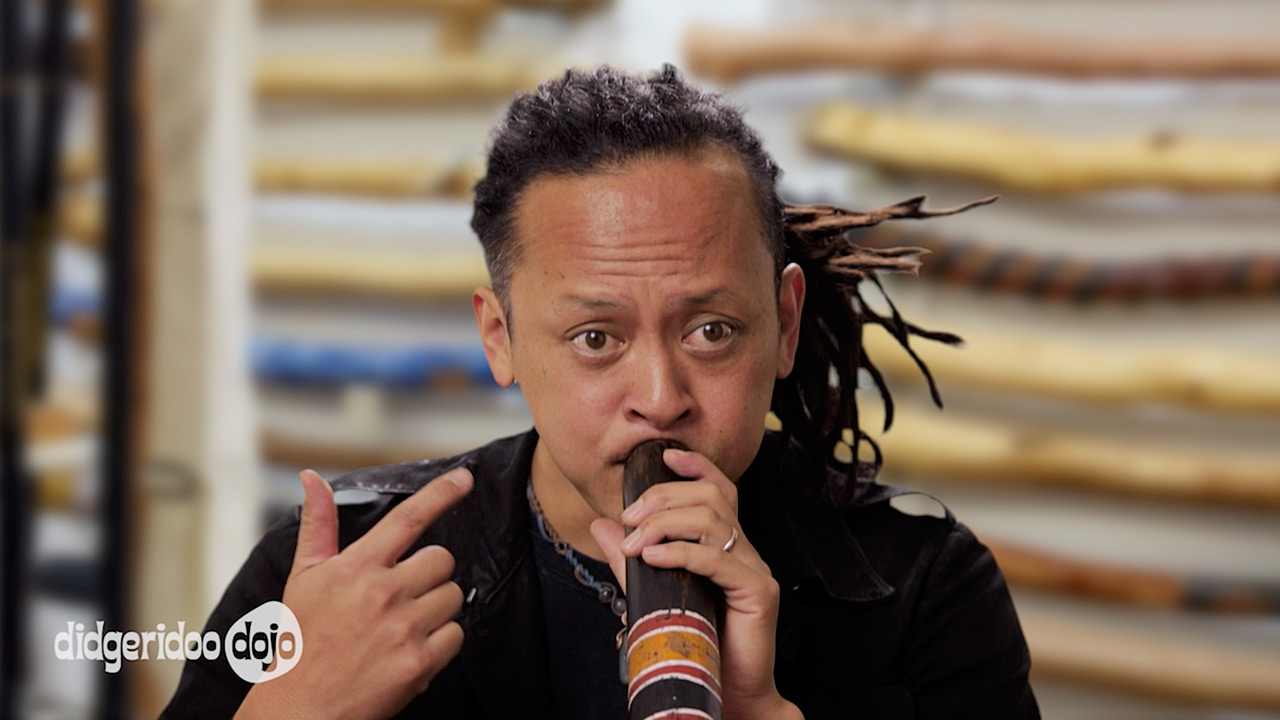
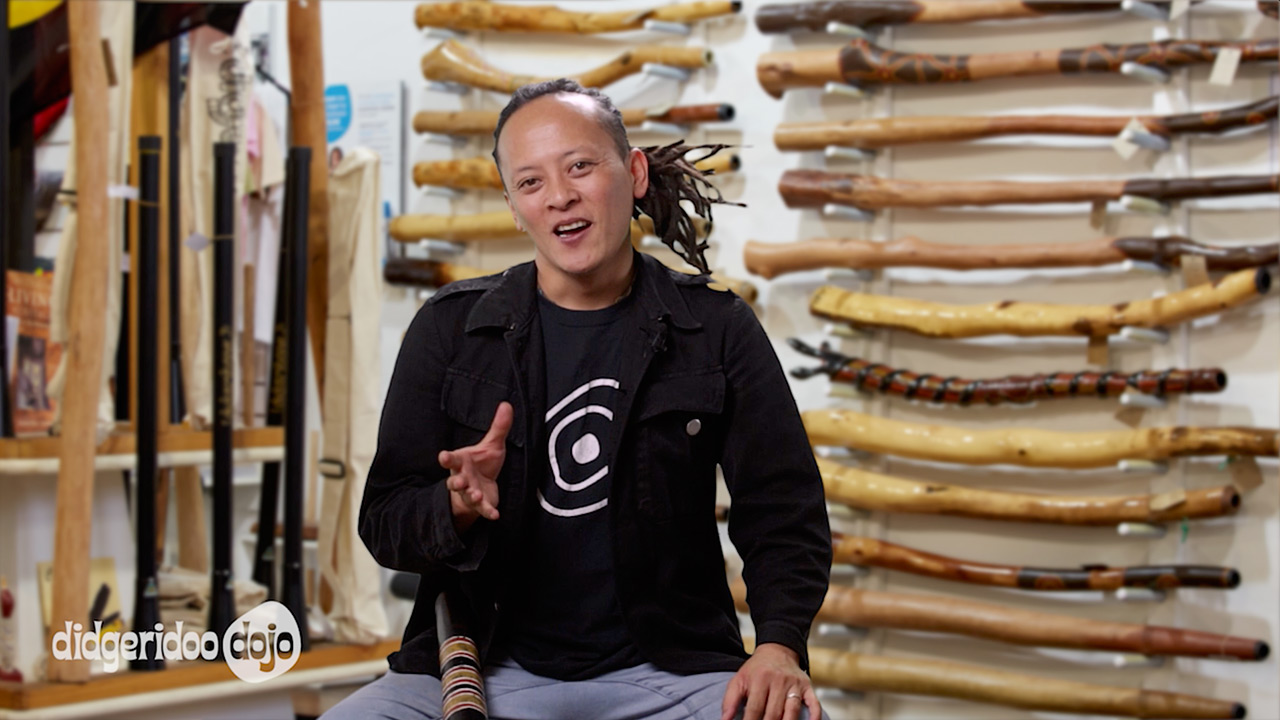

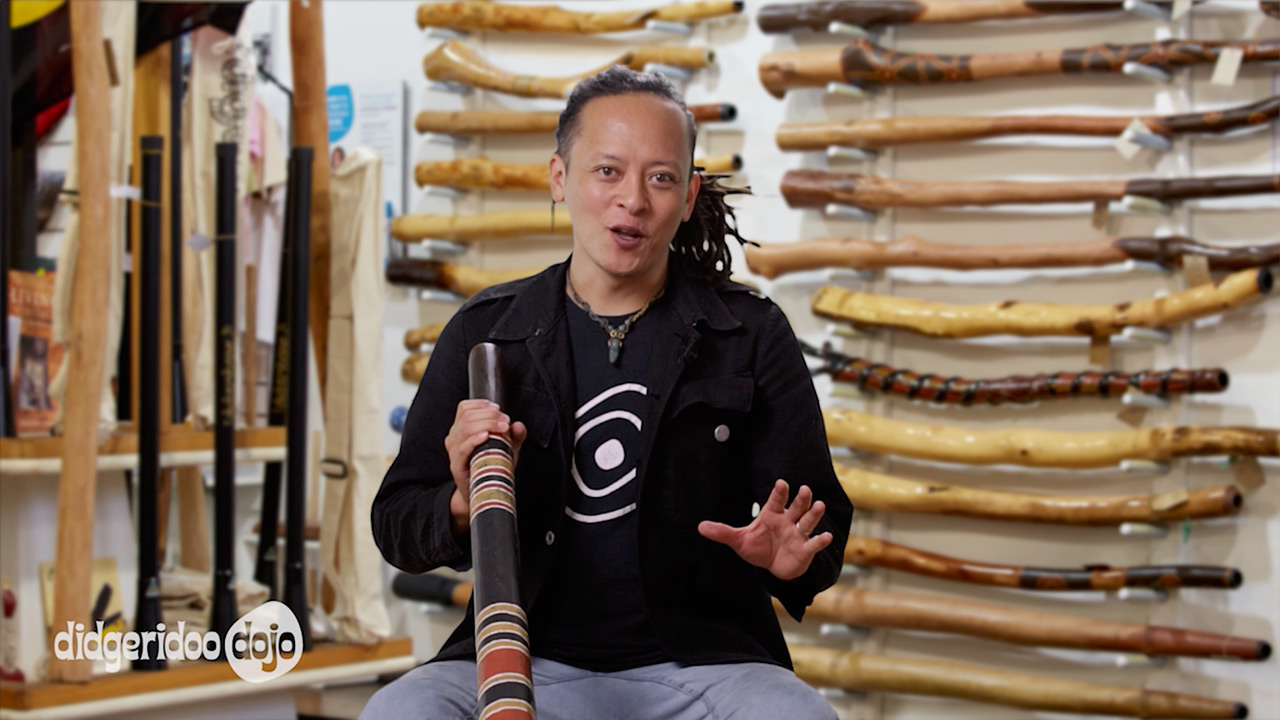
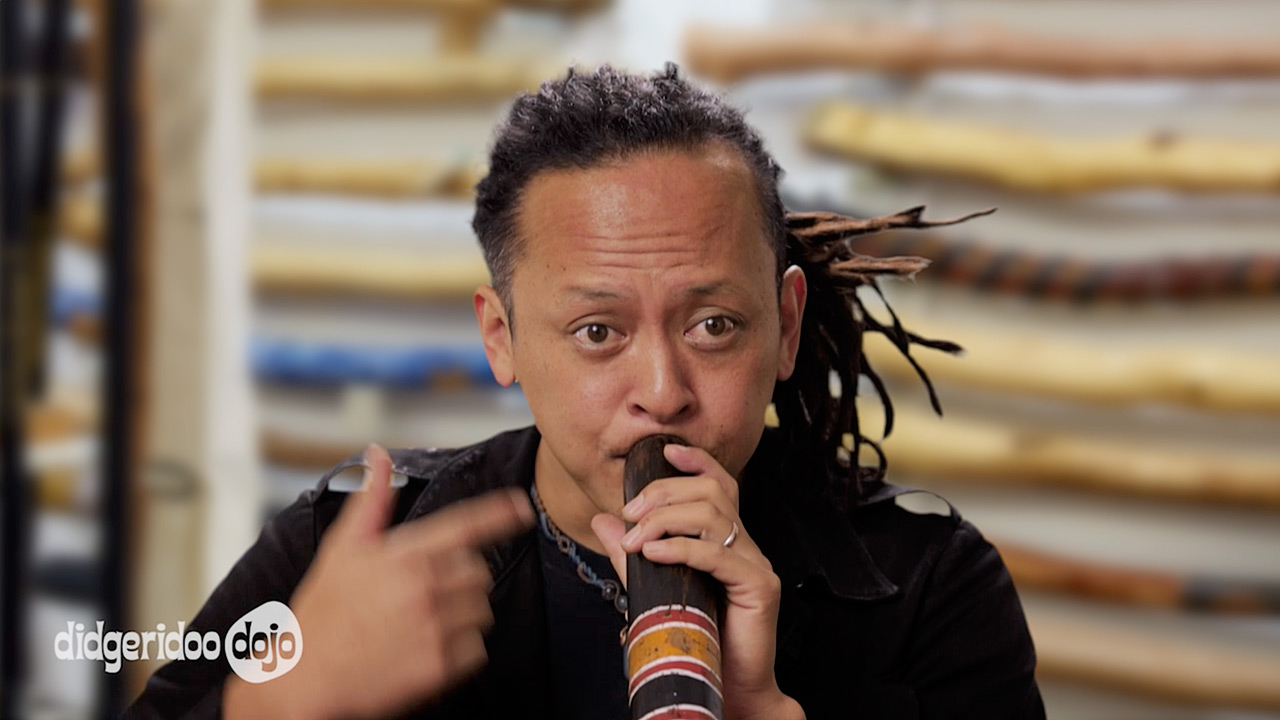
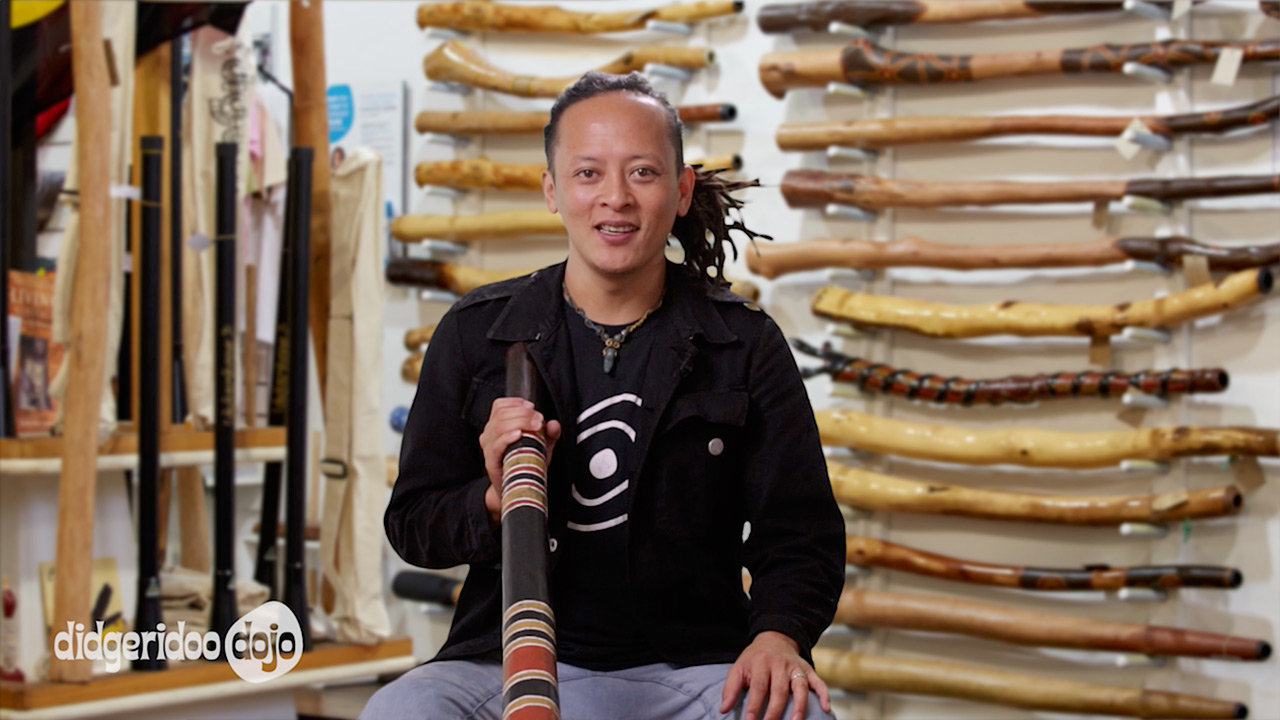
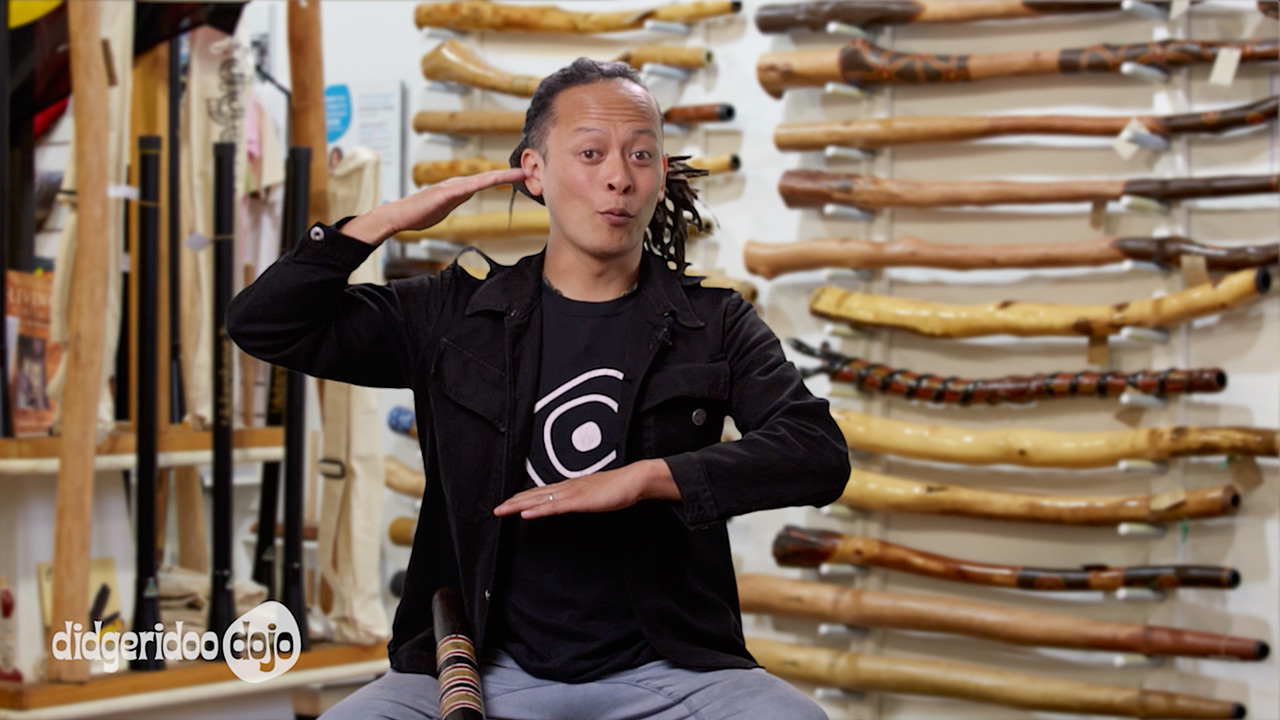
 Circular Breathing Lessons that are easy to follow, easy and fun!
Circular Breathing Lessons that are easy to follow, easy and fun!